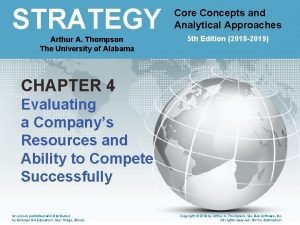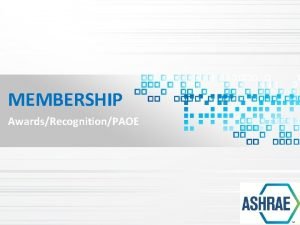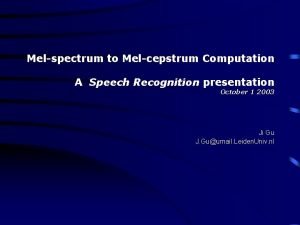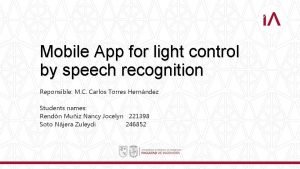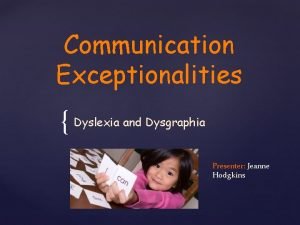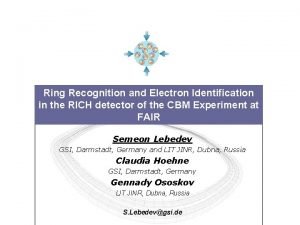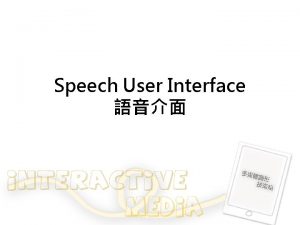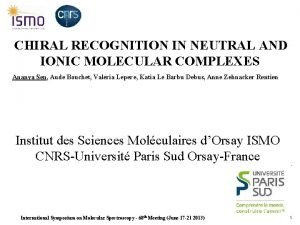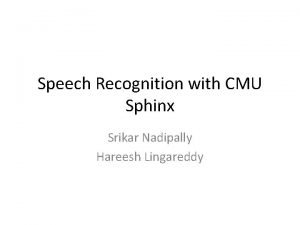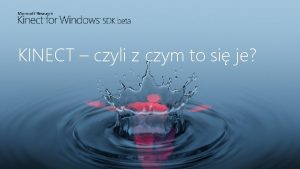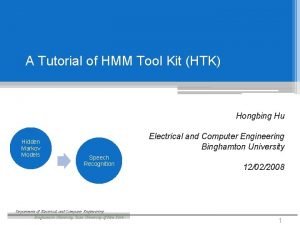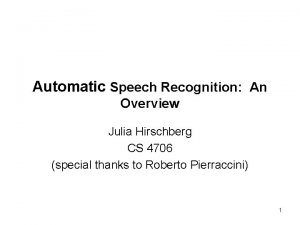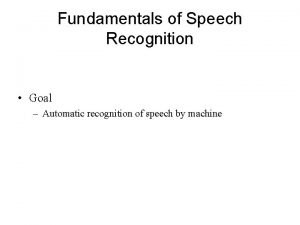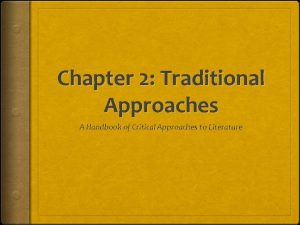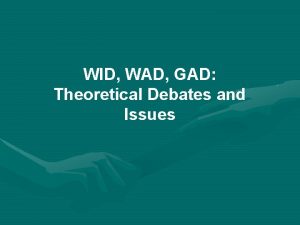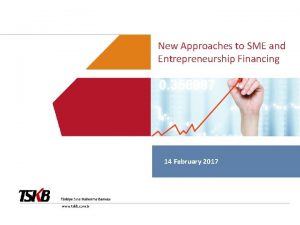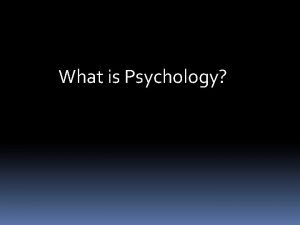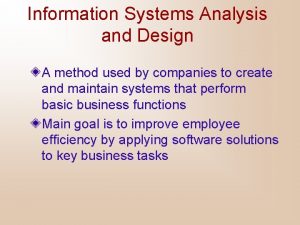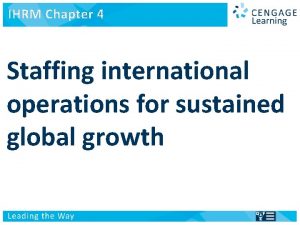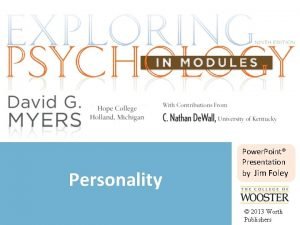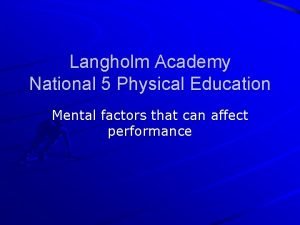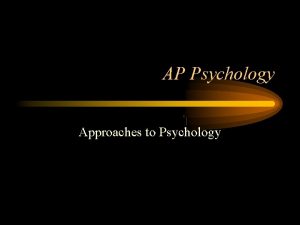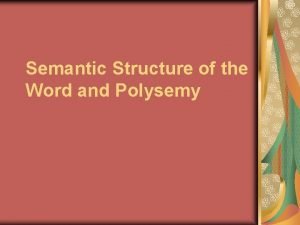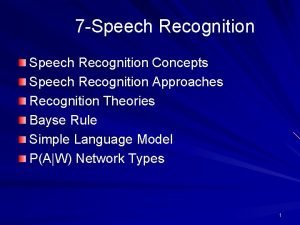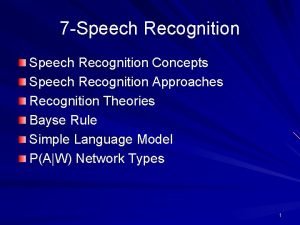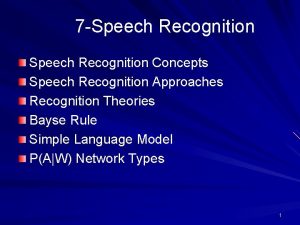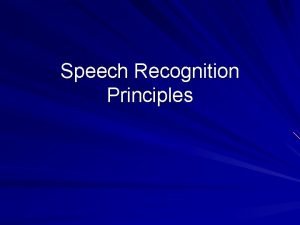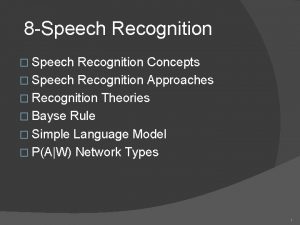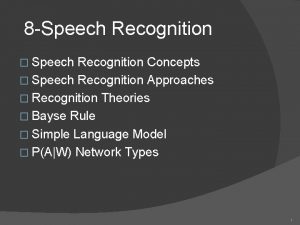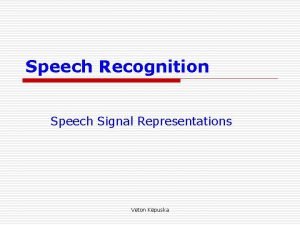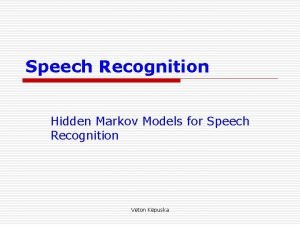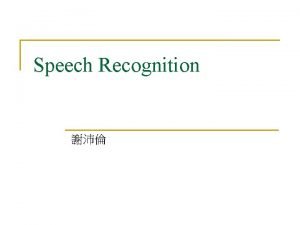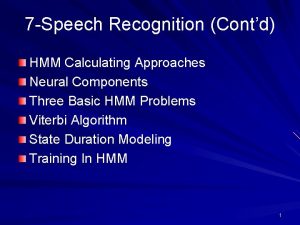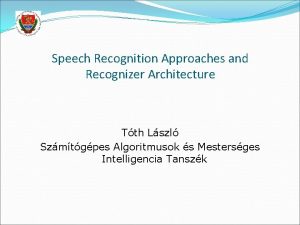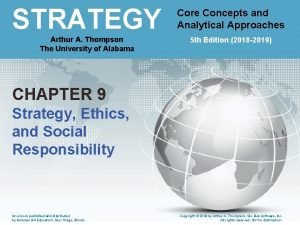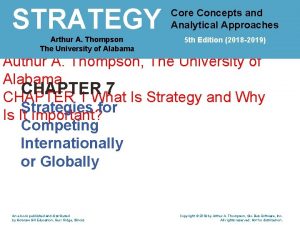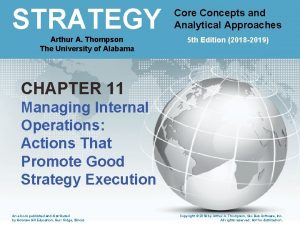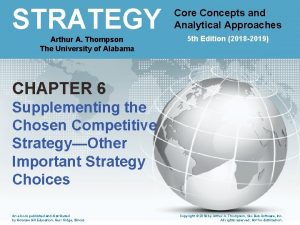7 Speech Recognition Concepts Speech Recognition Approaches Recognition


































- Slides: 34

7 -Speech Recognition Concepts Speech Recognition Approaches Recognition Theories Bayse Rule Simple Language Model P(A|W) Network Types 1

7 -Speech Recognition (Cont’d) HMM Calculating Approaches Neural Components Three Basic HMM Problems Viterbi Algorithm State Duration Modeling Training In HMM 2

Recognition Tasks Isolated Word Recognition (IWR) Connected Word (CW) , And Continuous Speech Recognition (CSR) Speaker Dependent, Multiple Speaker, And Speaker Independent Vocabulary Size – Small <20 – Medium >100 , <1000 – Large >1000, <10000 – Very Large >10000 3

Speech Recognition Concepts Speech recognition is inverse of Speech Synthesis Text Speech Phone Processing Sequence NLP Speech Recognition Speech Processing Text Speech Understanding 4

Speech Recognition Approaches Bottom-Up Approach Top-Down Approach Blackboard Approach 5

Bottom-Up Approach Signal Processing Knowledge Sources Feature Extraction Voiced/Unvoiced/Silence Segmentation Signal Processing Sound Classification Rules Feature Extraction Phonotactic Rules Segmentation Lexical Access Language Model Segmentation Recognized Utterance 6

Top-Down Approach Inventory Word of speech Dictionary Grammar recognition units Feature Analysis Syntactic Hypo thesis Unit Matching System Lexical Hypo thesis Utterance Verifier/ Matcher Recognized Utterance Task Model Semantic Hypo thesis 7

Blackboard Approach Acoustic Processes Environmental Processes Lexical Processes Black board Semantic Processes Syntactic Processes 8

Recognition Theories Articulatory Based Recognition – Use from Articulatory system for recognition – This theory is the most successful until now Auditory Based Recognition – Use from Auditory system for recognition Hybrid Based Recognition – Is a hybrid from the above theories Motor Theory – Model the intended gesture of speaker 9

Recognition Problem We have the sequence of acoustic symbols and we want to find the words that expressed by speaker Solution : Finding the most probable of word sequence by having Acoustic symbols 10

Recognition Problem A : Acoustic Symbols W : Word Sequence we should find so that 11

Bayse Rule 12

Bayse Rule (Cont’d) 13

Simple Language Model Computing this probability is very difficult and we need a very big database. So we use from Trigram and Bigram models. 14

Simple Language Model (Cont’d) Trigram : Bigram : Monogram : 15

Simple Language Model (Cont’d) Computing Method : Number of happening W 3 after W 1 W 2 Total number of happening W 1 W 2 Ad. Hoc Method : 16

Error Production Factor Prosody (Recognition should be Prosody Independent) Noise (Noise should be prevented) Spontaneous Speech 17

P(A|W) Computing Approaches Dynamic Time Warping (DTW) Hidden Markov Model (HMM) Artificial Neural Network (ANN) Hybrid Systems 18

Dynamic Time Warping

Dynamic Time Warping

Dynamic Time Warping Use Dynamic Programing (DP): (s, t) ----> (u, v) => (s, t) --> (w, x) < + > (w, x) --> (u, v) - Recursive : O(n!) or O((I*J)!) - DP : O(I*J)

Dynamic Time Warping for I=J=50 then O(recursive) / O(DP) ~ 1. 2 * 10^61

Dynamic Time Warping Detail of DTW - Distance - Selecting Same Frams

Dynamic Time Warping

Dynamic Time Warping

Dynamic Time Warping Search Limitation : - First & End Interval - Global Limitation - Local Limitation

Dynamic Time Warping Global Limitation :

Dynamic Time Warping Local Limitation :

Artificial Neural Network . . . Simple Computation Element of a Neural Network 29

Artificial Neural Network (Cont’d) Neural Network Types – Perceptron – Time Delay Neural Network Computational Element (TDNN) 30

Artificial Neural Network (Cont’d) Single Layer Perceptron. . . 31

Artificial Neural Network (Cont’d) Three Layer Perceptron. . . 32

Hybrid Methods Hybrid Neural Network and Matched Filter For Recognition Acoustic Output Units Speech Features Delays PATTERN CLASSIFIER 33

Neural Network Properties The system is simple, But too much iteration is needed for training Doesn’t determine a specific structure Regardless of simplicity, the results are good Training size is large, so training should be offline Accuracy is relatively good 34
 Strategy core concepts and analytical approaches
Strategy core concepts and analytical approaches Awards recognition concepts
Awards recognition concepts Awards recognition concepts
Awards recognition concepts Awards recognition concepts
Awards recognition concepts Speech recognition presentation
Speech recognition presentation Speech recognition app inventor
Speech recognition app inventor Deep learning speech recognition
Deep learning speech recognition How dyslexic see words
How dyslexic see words Electron speech to text
Electron speech to text Dragon speech recognition
Dragon speech recognition Aude leperre
Aude leperre Cmu speech recognition
Cmu speech recognition Kinect for windows runtime
Kinect for windows runtime Htk tutorial
Htk tutorial Julia speech recognition
Julia speech recognition Speech recognition
Speech recognition Fundamentals of speech recognition
Fundamentals of speech recognition Data quality and data cleaning an overview
Data quality and data cleaning an overview Traditional approach in literature
Traditional approach in literature Similarities of wid wad and gad brainly
Similarities of wid wad and gad brainly New approaches to sme financing
New approaches to sme financing Applying critical approaches to literary analysis
Applying critical approaches to literary analysis Power bi governance and deployment approaches
Power bi governance and deployment approaches Where do most psychologists work
Where do most psychologists work Approaches to systems development
Approaches to systems development Public health approaches
Public health approaches Roi indicators for calculating international assignments
Roi indicators for calculating international assignments Social cognitive approaches to personality
Social cognitive approaches to personality Corporate environmental ethics
Corporate environmental ethics Mental factors pe examples
Mental factors pe examples Contemporary approaches to psychology
Contemporary approaches to psychology Sales types
Sales types Semantic structure of the word
Semantic structure of the word Traditional approach in literary criticism
Traditional approach in literary criticism Traditional managerial approach
Traditional managerial approach
